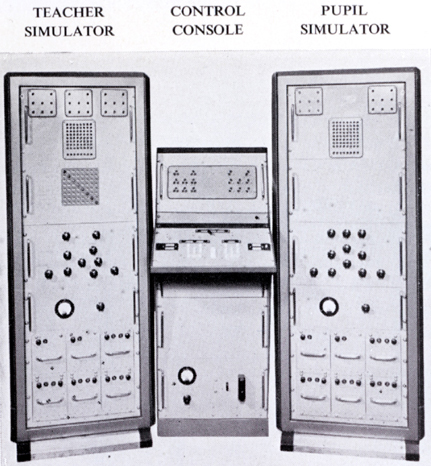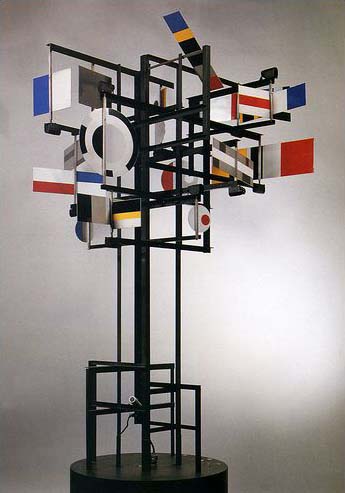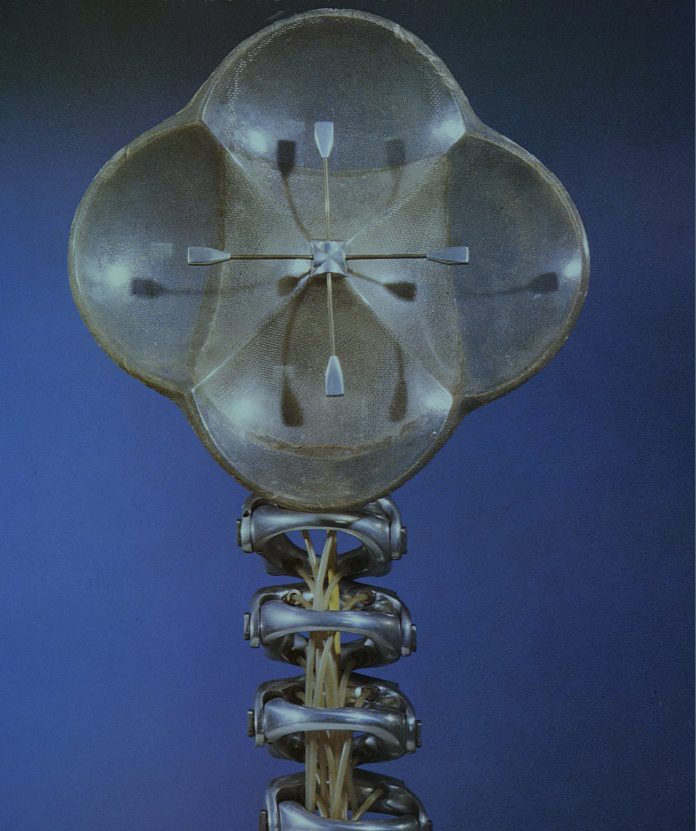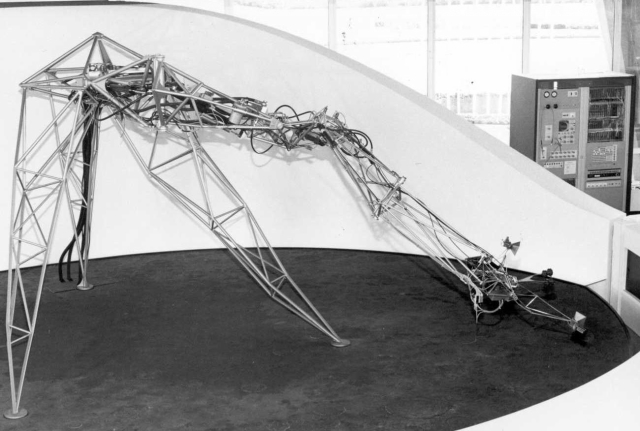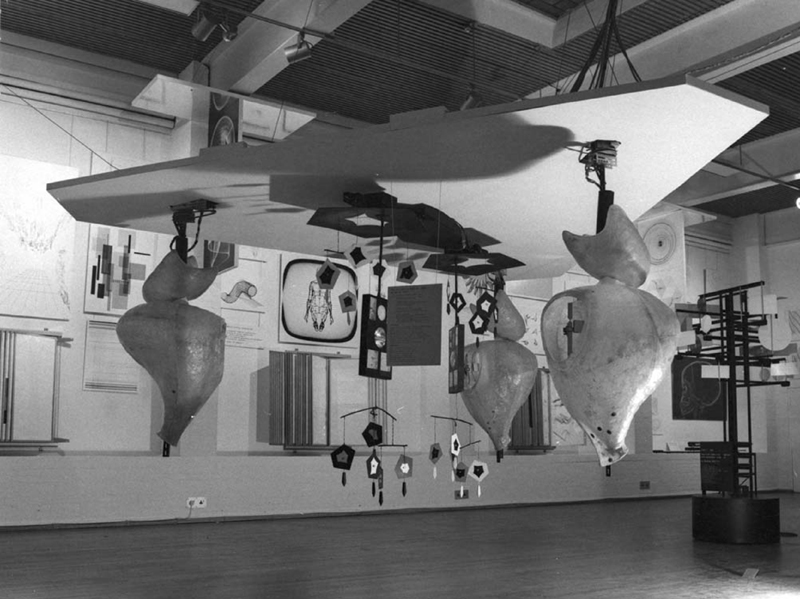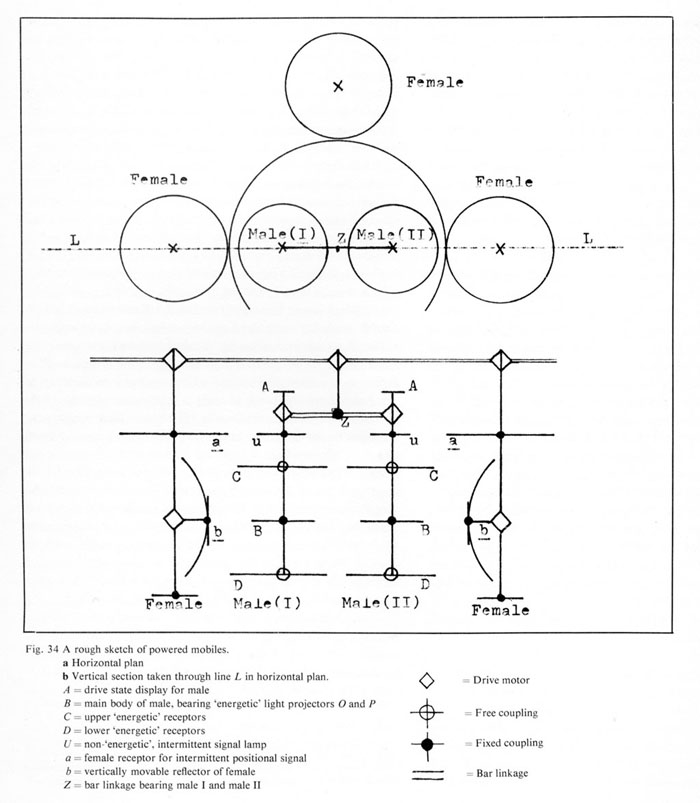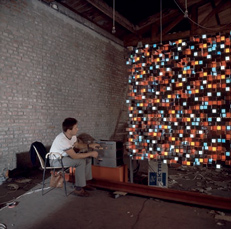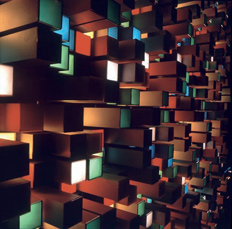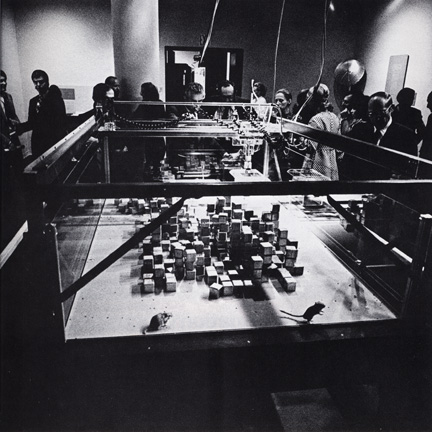IASLonline NetArt: Theory
Thomas Dreher
History of Computer Art
II. Cybernetics
II.3 Cybernetic Sculptures
- II.3.1 Pioneer Works
- II.3.1.1 Gordon Pask´s "Musicolour System"
- II.3.1.2 Nicolas Schöffer´s "CYSP 1"
- II.3.2 "Cybernetic Serendipity"
- II.3.2.1 The Exhibition in London
- II.3.2.2 Edward Ihnatowicz´s "SAM" and "Senster"
- II.3.2.3 Gordon Pask´s "Colloquy of Mobiles"
- II.3.3 Light and Sound Installations by James Seawright and Vladimir Bonacic
- II.3.4 Nicolas Negroponte, the Architecture Machine Group and "Seek"
- Illustrations Part II: Cybernetic Sculptures: PPT / PDF
- Table of Contents
- Bibliography
- Previous Chapter
- Next Chapter
In his book "An Approach to Cybernetics" (1961) Gordon Pask presents "learning machines". Pask designates "Eucrates" (1955) as "simulating a pupil-teacher system". 1 The model reconstructs the behaviour of "real neurones" and their "`absolute refractory period´". 2 The reactions of the "motor-elements" to the input are varying because of a shifting threshold: The threshold increases after the first input with the consequence for learners that they have to wait with further inputs until the threshold falls. "`Memory´-elements" react to the output of the "motor-elements". The "`memory´-elements" are constructed following the example of "the synaptic connections of a neurone" 3: "Now it is obvious that various modes of activity and various forms of interaction [between a pupil and a teacher or the learning machine] will build up the network." Pask writes this sentence after a short explanation of possible "interconnections" between "motor-elements" and the learning activities within the "network". Capable of surviving within the "network" are only the connections which "mediate a favourable behavior". 4
Pask, Gordon: Solartron EUCRATES II, ca. 1956 (Pask: Approach 1961, pl.I 8(i)).
"Musicolour" (1953-57, built in collaboration with Robin McKinnon-Wood) was a reactive system for theater productions. The system´s analogue computer was transported from performance to performance.
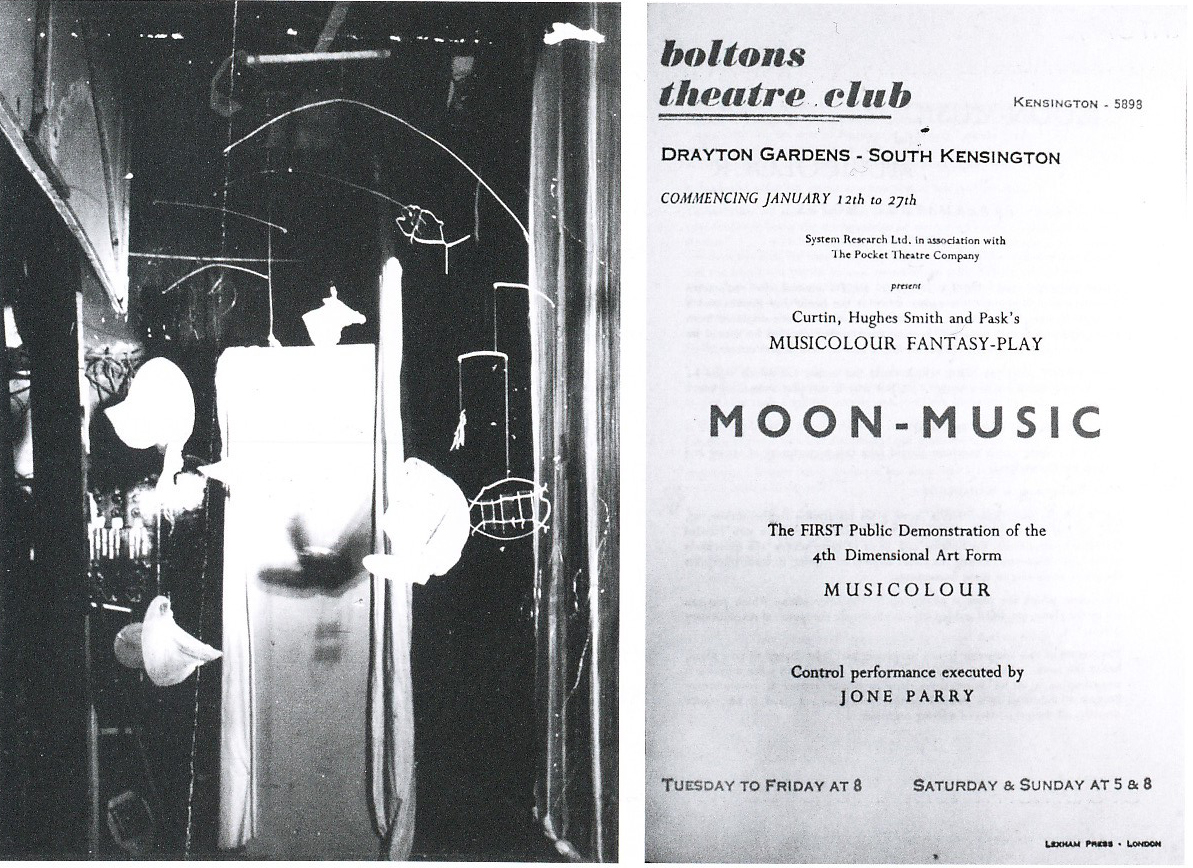
Pask, Gordon: Musicolour, Boltons Theatre Club, South Kensington 1954.
Left: Stage with a projection screen for Musicolour.
Right: Moon-Music, playbill (Rosen: Control 2008, p.139).
If a musician produced input via a microphone for "Musicolour", then the system reacted with visual output – "a predetermined vocabulary of visual symbols". The "visual vocabulary" could be modified from performance to performance. 5 Pask describes the system´s procedures as including "a rudimentary learning facility" 6 being capable to modify the sound-image relation in the course of the performance. If the music stopped then the system reacted with a growing sensitivity to each kind of sounds. In practice, this growing sensitivity had to be moderated by an "arbitrary gain control circuit". "Musicolour" reacted for a while to "repetitive input" with a constant output before it stopped to react. The musician was forced to change her/his performance to get again the visual output. A musician could follow the reactions of the machine and could try after "several gambits" 7 to modify the audio input and to develop ways to control the audio-visual correlations.
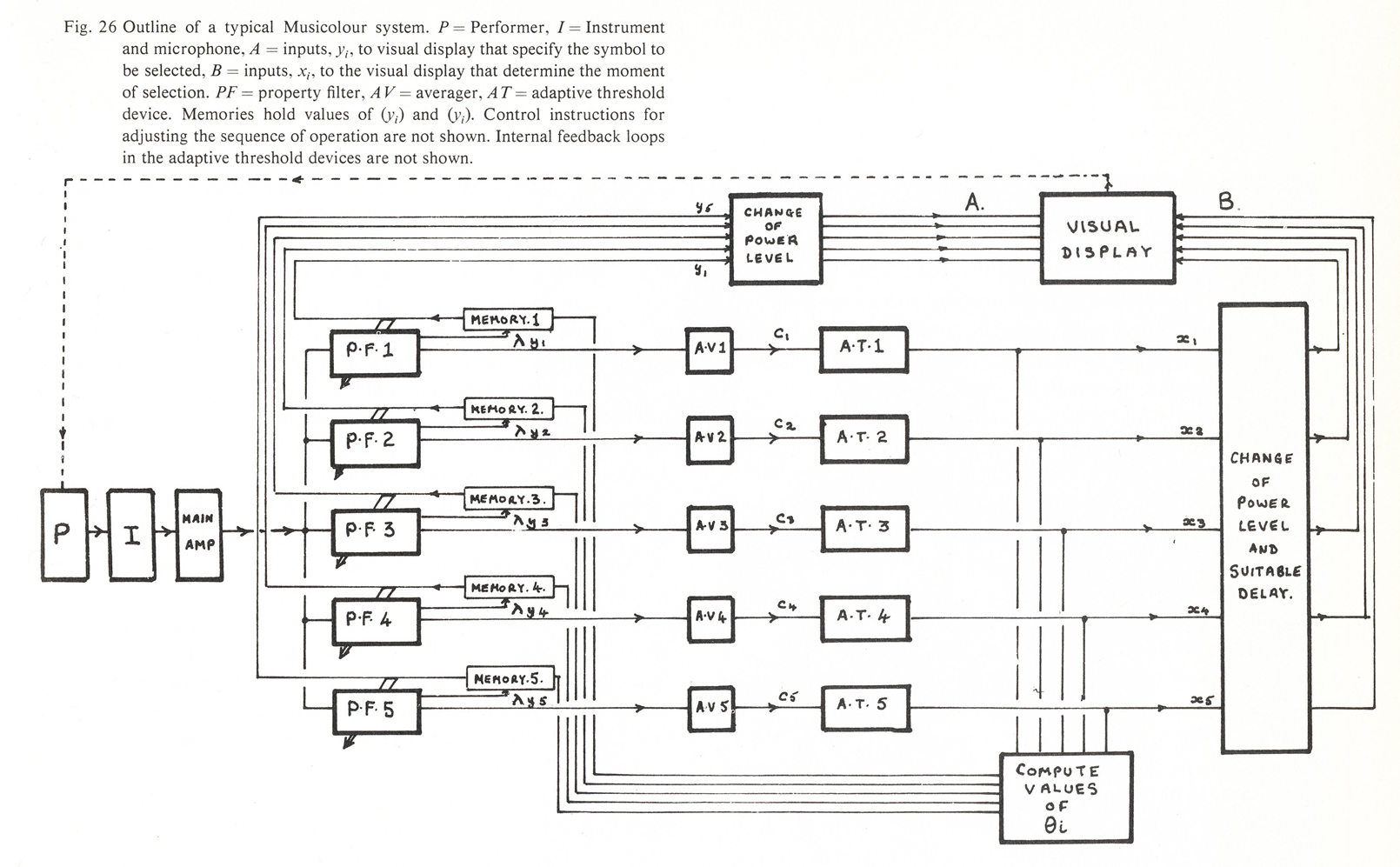
Pask, Gordon: Musicolour, 1953-57, circuit diagram (Pask: Comment 1971, p.79, fig. 26).
"Property filters" select sounds following different and modifiable criteria. On the one hand the storage units of each filter can memorize the filtered sounds and these sounds can be utilized to influence the visual output´s "power level". On the other hand the filtered sounds can be processed with "averagers" and "adaptive threshold devices" with "internal feedback loops". The "threshold devices" install a lower limit causing a suppression of too weak input. The conflation of the processed and stored sounds influences the visual output that in turn inspires the musician. Light projections direct the visual output to a projection surface. The light is emitted through color and pattern filters constructed as controllable wheels or reflectors. 8
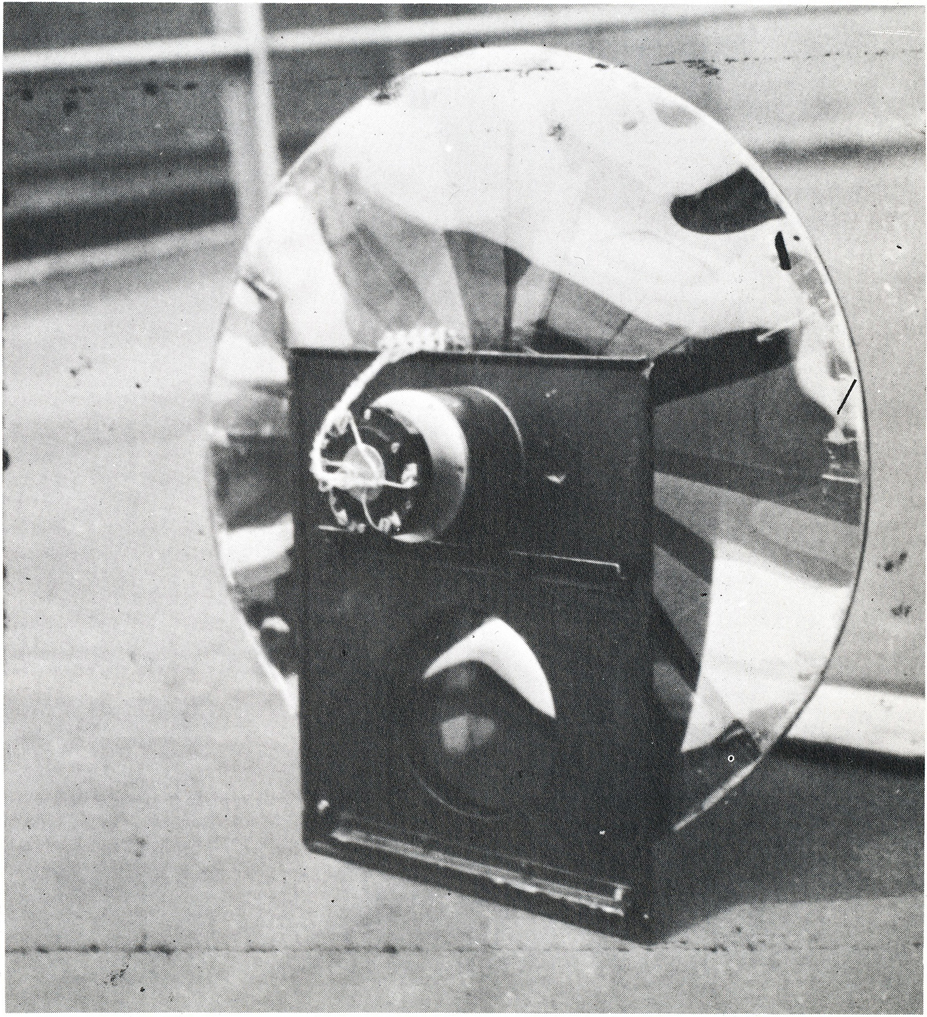
Pask, Gordon: Musicolour, 1953-57, projection wheel controlled by a servomechanism (Pask: Comment 1971, p.81, fig.27).
For light modifications an "electro-chemical display" is developed for "Musicolour" between 1954 and 1957. Bowls are placed on rotating supports. The bowls contain electrolyte solutions and indicators: The pH of the solutions is changed by electrolysis. These changes activate electrodes mounted on the bowls. The activated electrodes in turn navigate the projections of colour patterns. In his description of the "display" Pask doesn´t refer to the response system mentioned above. 9
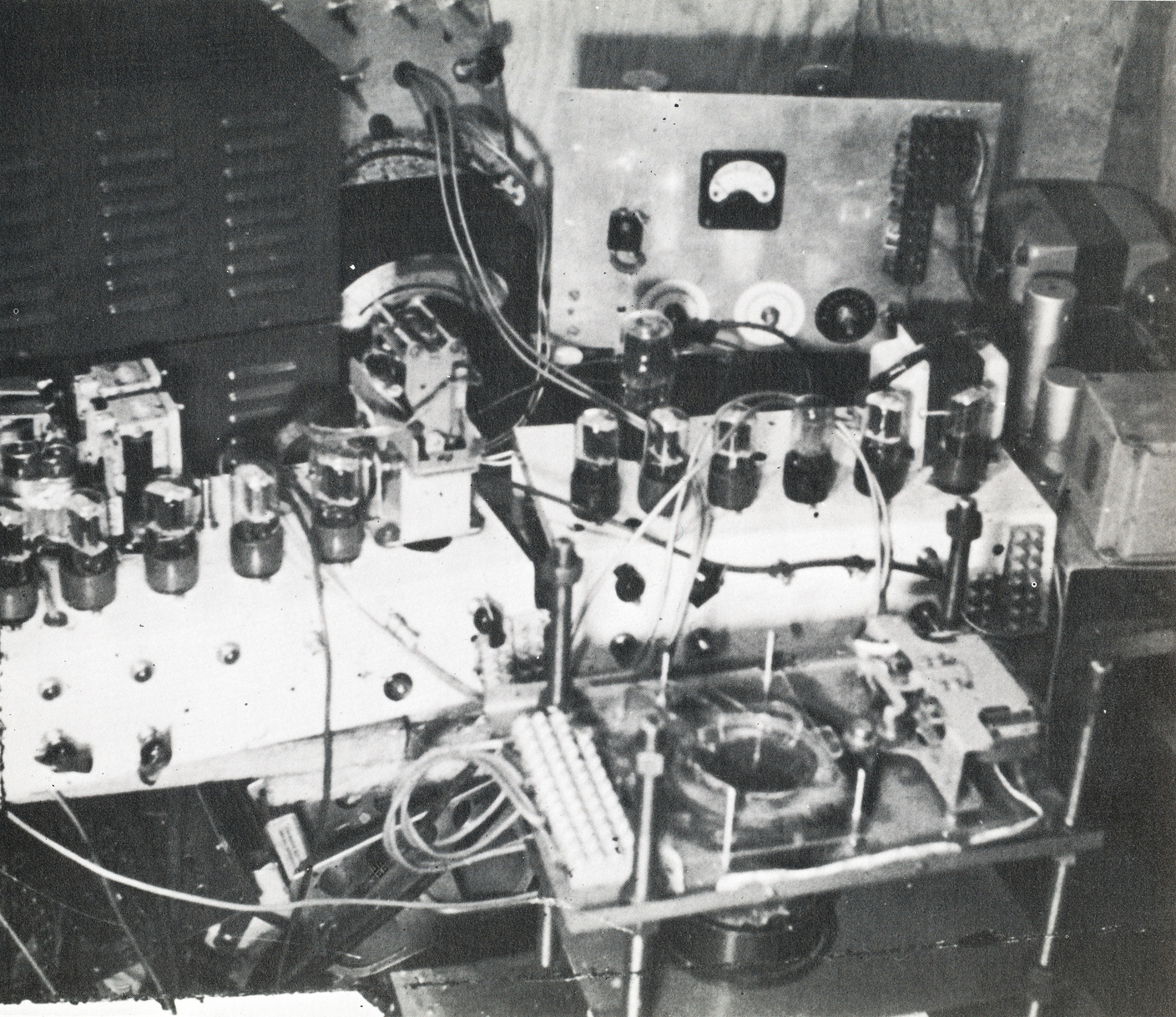
Pask, Gordon: Musicolour, 1953-57, electrochemic system (Pask: Comment 1971, p.85, fig.31).
Pask designates the musician as a "converse participant" of the "learning mechanism" of "Musicolour". 10 Machine and musician should accomodate to each other: Both sides `learn´. 11 How redundancy is avoided by modifications depends on one side from the "Musicolour´s " changing ways to react 12, on the other side of "the observer´s [resp. the musician´s] frame of reference" 13: Musicians explore the "Musicolour system´s" capabilities to react and conclude how they can create their next actions.
Pask´s "Musicolour" offers a "responsive environment" 14 being integratable as a partial system with participant into wider performance systems. With "Musicolour" Pask became a pioneer of computer art.
In 1956 Nicolas Schöffer realised "CYSP 1" as a mobile kinetic sculpture. Round and rectangle aluminium plates rotate in a steel structure meanwhile its basis drives in the space either of an exhibition or outdoors. Little engines move the plates. The basis contains electric motors for movements on four rubber wheels in two speeds, accumulators for the electricity supply and an "electronic brain" («cerveau électronique», vacuum tube based) by Philips organizing the navigation between obstacles and the rotation of the aluminium plates. 15
The "electronic brain" includes a random generator organizing the self mobility. If the kinetic sculpture´s self navigation around the obstacles of an environment is overstressed then observers can intervene from a control desk being connected with the sculpture via radar. This description of Reuben Hoggett is contradicted by Jean-Noël Montagné who was involved in a recent restoration of "CYSP 1". Following Montagné the first version of "CYSP 1" had an antenna. It was used for experiments with a "capacitive sensor" "but the electronic has too many natural and in-board parasites". Montagné describes the control of "CYSP 1" as either "autonomous" or by a "remote control" connected "by cable". 16
Schöffer, Nicolas: CYSP 1, 1956. Left: exhibition, Institute of Contemporary Arts, London 1960.
Photoelectric cells and a microphone are used as sensors registrating changings of light intensity, colors, and sound volume. These sensors supply with the input for the navigation of the moving parts. The "electronic brain" organizes the simultaneous control of the speed of the plates´ rotation up to "stroboscopic effects" and the movement of the basis. 17 The "electronic brain´s" coordination varies the reactions of "CYSP 1" to external events by "disturbing parameters" 18 and avoids predictability.
Jacques Bureau, the developer of the "electronic brain" integrated in "CYSP 1", and the artist use Ashby´s terms "homeostasis" and "homeostat" (see chap. II.1.5, II.2.1) for the capabilities to move and adapt to external events featured by "CYSP 1". 19 The system moving itself by random generators and the limited adaptability to environmental conditions are capabilities common to Ashby´s "Homeostat" and "CYSP 1". Schöffer creates not only a moved three-dimensional object as kinetic art but constructs cybernetically a relation to the environment using an adaptive system with self-navigated movements.
The "electronic brain" of "CYSP 1" transfers the sensors´ input caused by several external factors in a program for navigation and movements. Meanwhile the "Homeostat" is an experimental arrangement with controls turned by humans to cause disturbances, they are caused in "CYSP 1" by changing environmental conditions. The internal balance of the "Homeostat´s" four subsystems reacting to each other is in "CYSP 1" replaced by an electronic control system. After the self navigation of William Grey Walter´s robots (see chap. II.2.3) follows in "CYSP 1" a self navigation controlled by programmed electronics.
Jasia Reichardt followed a suggestion by the German philosopher Max Bense when she started in autumn 1965 the preparations for the exhibition "Cybernetic Serendipity". 20 From August to October 1968 the London Institute of Contemporary Arts exhibited predominantly examples for the uses of computers in art, literature, and music. Following Reichardt 60.000 humans visited the exhibition on "The Computer and the Arts". 21 Beside Schöffer´s then twelve year old "CYSP 1" cybernetic sculptures of Edward Ihnatowicz and Gordon Pask have been exhibited for the first time in "Cybernetic Serendipity". In 1968 they demonstrate the development status of three-dimensional works reacting to visitors´ actions.
The catalogue of the exhibition and two publications later edited or written by Reichardt document the development for the art for and with the computer. 22
Edward Ihnatowicz´s "Sound Activated Mobile", in short "SAM" (1968), reacted to more quiet sounds. A sound reflector made in fibreglass contained four microphones in a cross-shaped configuration. The eight hydraulic controlled vertebrae cast in aluminium constituted a mechanical backbone. The vertebrae rotated and directed a reflector to the input of the microphones. The microphones were mounted in pairs, two vertical and two horizontal to each other, and each of the pairs were connected with their own analog system. These two systems measured the time intervals between their microphones and used this measurement to `recognize´ the direction out of which a sound event came. "SAM" then used the hydraulics of the backbone´s vertebrae to direct the reflector to these events.
Ihnatowicz, Edward: SAM, 1968, exhibition "Cybernetic Serendipity", Institute of Contemporary Arts, London 1968.
John Billingsley developed the analog circuit for the measurement of the audio input, meanwhile Ihnatowicz realised the `backbone´, its hydraulics, and the analog computer being hidden in the socle and used for the coordination of the motions. The technology of the hydraulicservo system was based on biological prefigurations. The reflector looked like a four-leaved clover, a flower or a head.
Ihnatowicz, Edward: SAM, 1968 (Ihnatowicz: Cybernetic Art 1986, Cover).
Ihnatowicz entertained the visitors with the surprising skills of an environmentally sensitive system. It was not his main interest to present a model of human intelligence, as William Grey Walter understood his robots (see chap. II.2.3). 23
In his catalogue contribution to "Cybernetic Serendipity" Ihnatowicz announced a "large structure" "to be operated by a computer." 24 Ihnatowicz prepared at that time The Senster. In September 1970 it was installed on a round basis in the foyer of the "Evoluon", a technical museum at Philips´ factory site in Eindhoven. Until December 1973 it reacted each day to the visitors´ motions and sound productions. From September to December 1970 Ihnatowicz stayed in the Evoluon to program a computer Philips P 9201 in assembly language for an input via punch cards. He used the visitors as test persons. 25
Ihnatowicz, Edward: The Senster, 1970, in Evoluon, Eindhoven.
"Senster" was a tubular steel construction on three static legs carrying a mobile structure. The steel tubes of this part were moved by six independent electrohydraulic servo systems. The tank and the pumps of the hydraulic systems have been installed under the basis. The computer controlled hydraulic cylinders and the potentiometers of the servo systems. The mobile structure largely overhanging in the direction of the visitors orientated itself by following the input of its sensors. These sensors were installed on a mobile part mounted on the overhanging end of the mobile structure.
Ihnatowicz, Edward: The Senster, 1970, in Evoluon, Eindhoven.
When Ihnatowicz constructed the joints he was inspired by lobster claws because they are able remarkably easy to move with six simple swivel joints. The artist constructed "Senster´s" mobile structure as a big lobster claw. He substituted the claw with a mobile fixing of the sensors.
Two Doppler radar units were mounted on arms overhanging on the left and right side of the microphones. These units recognized the visitors´ actions. The pair-by-pair configuration of the four microphones between the Doppler units enabled the technical system to recognize the direction of a sound. At first "Senster" moved these microphones into the direction of sound events, then in the case of longer lasting sounds it moved the mobile parts of the tubular steel construction to the sound sources, too. Loud noises and fast body actions cause retreating movements of the mobile structure. "Senster" reacted to body actions below the threshold for the relevant audio- and radar input by turning itself into directions offering stronger input. Following Ihnatowicz the observers´ actions were not determined by "Senster´s" form but by its moves. 26
Ihnatowicz, Edward: The Senster, 1970, four microphones.
Visitors of the Evoluon were diverted by sounds produced by other visitors exploring the "Senster´s" capabilities. Without consulting the artist the Senster´s" program was changed and, finally, in 1973 the now uninteresting cybernetic sculpture was removed. 27
Meanwhile Ihnatowicz developed in "SAM" and "Senster" programs for machine bodies reacting with motions to the environment and did with the work as an object isolated from its surrounding nothing more than to modificate the established delineation between art space and environment, Gordon Pask (see chap. II.3.2) and James Seawright (see chap. II.3.3) realised new concepts of the integration of observers into the work space in installations being able to react to observers´ operations.
Gordon Pask´s "Colloquy of Mobiles" was an installation offering the visitors of "Cybernetic Serendipity" to use torches as means in interactions with the motions of its five parts. Five hanging objects navigated their motions mutually via beams of light and light reflexes. Three organically formed objects hung at the truncated corners of a triangle hanging horizontally at the ceiling. Between these objects two mobiles with inorganically formed elements hung on a further element mounted on the big triangle and rotating under it horizontally. These five objects hung on vertical axes that were rotated by electric motors. Pask designated the mobiles with inorganic formed elements as "Males" and the three organic elements clad with fibreglass bodies as "Females". Yolanda Sonnabend drafted the semitransparent fibreglass bodies illuminated from inside. 28 The "Males" constituted an inner rotating system with the "Females" circulating around them.
Pask, Gordon: Colloquy of Mobiles, 1968, exhibition "Cybernetic Serendipity", ICA London 1968 (rear right: Schöffer, Nicolas: CYSP 1, 1956) .
The "Males" and "Females" are programmed to relate themselves to each other by contacts produced by light rays and light reflexes. These contacts cause the rotating objects to change their motion sequences. The motion sequences of the "Males" and "Females" are controlled by a computer located outside the installation. The installation is connected to the computer by cables laid from the static horizontal element to the ceiling. 29 The "Males" contain photo cells and elements emitting orange and dark red light. Light reflecting objects are fixed in the "Females´" openings. The "Males" come closer to the "Females" by rotations of the mobile horizontal element and by their own motions. In some positions a "Male" is only able to follow its goal by hampering the other "Male". 30
Pask, Gordon: Colloquy of Mobiles, 1968, exhibition "Cybernetic Serendipity", ICA London 1968 (Pask: Comment 1971, p.97, fig.40).
After phases of inactivity the fibreglass bodies of the "Females" are illuminated by lights from inside and the "Males" start to emit light rays that can hit mirrors in the openings of the "Females" fibreglass-bodies. Some light interactions provoke the "Males" to change the light colour and the rotation speed if the "Females" redirect the light rays of the "Males" to their photo cells. In the course of such light interactions both sides send sound signals. Sound signals emitted by the "Males" are received by a cooperating "Female" and replied by a corresponding sound. 31 After this audio cooperation a sequence with visual cooperations can follow.
The mobile elements pursue "goals" – for example the heterosexual cooperation in one of both rotation speeds 32 – in a system organizing the cooperation on several levels: The "goals" are compartmentalised in "sub-goals". The "Females" and "Males" pursue "goals" independently of each other. They are not only able to compete with each other, but also to prohibit themselves in pursue of their "goals". 33
Pask, Gordon: Colloquy of Mobiles, 1968, ground and vertical plan of the mobile elements (Pask: Comment 1971, p.90, fig.34).
The mobile elements need memories for their cooperations to be able to store which element corresponded in which action phase with their "goals". The actual cooperation phase until the next phase is stored by the "short-term memory". The "long-term `memory´" stores elder cooperation experiences and learning processes. Potential partners are able to memorize the different preferences developed by the mobile elements and to adapt themselves to the preferences. 34.
Visitors of "Cybernetic Serendipity" could intervene in the "aesthetically potent social environment" 35 using flashlights or mirrors and producing sounds. Visitors were enabled to influence the interaction between "Females" and "Males" by interventions and to use the system´s reactions in investigations of the programming. 36 Obviously "Colloquy of Mobiles" was capable to react in a sufficiently complex manner to attract observers for a longer period of time. The complexity of the system-internal capabilities of the five moving objects was the precondition to react to system-external changes and – with it – to interventions by the visitors.
After Ashby´s "Homeostat" (see chap. II.1) Pask offers a further model for the "law of requisite variety" (see chap. II.1.5) postulating the system-internal (system/system relations) differentiation as precondition for the system/environment relations. The "Homeostat´s" four subsystems constitute the environment mutually: The "Homeostat" is enabled to react to certain environmental conditions by a subdivision in internal system/environment conditions. The "Colloquy of Mobiles" features comparable relations. Not only learn the internal elements of "Colloquy of Mobiles" from each other, but also the installation is able to learn from external operations of observers: The work reacts to external events in the same way as it organizes the actions of its own elements.
Pask´s model includes the learning capability based on machinic memory missed by the participants of the ninth Macy Conference in 1952 in their discussion of Ashby´s "Homeostat" (see chap. II.2.2). The segmentation into several internal, separately and autonomously operating subsystems and the structuring in "short-term memory" and "long-term `memory´" constitute the "requisite variety" of the computing processes offering relations reconstructable for observers by the installation´s audio and visual manifestations. The interface between human and machine consists of the light and mirror actions as possibilities for human input as well as of the actions to be seen and heard as machinic output. Observers can recognize the possibilities for human input by reconstructions of the machinic `conversation´ between mobiles that can be interpreted as a rudimentary model of social interactions. The model is rudimentary as a test case for communication because it operates on the level of signals starting functions, not on the level of symbolic interactions.
In 1968 artists and musicians like Stephen Antonakos, Terry Riley, Charles Ross and Robert Whitman realised installations producing light and sound events for the exhibition "The Magic Theatre". James Seawright constructed "Electronic Peristyle" 37: an uncommon work for an uncommon exhibition.
He installed "power supplies" in a base under a sphere. The sphere was made of transparent plastic and contained 12 photocells. A "cylindrical metal box" with 12 "light beam projectors" was mounted underneath the "plastic sphere". The electronics in this vertical structure with round segments "was either digital (the earliest family of Motorola RTL logic chips)" or it contained "conventional analog transistor circuits." These electronics controlled the generation of sounds by "electronic synthesizer modules". These modules were developed by Robert Moog. He integrated his analog equipment in Seawright´s installation.
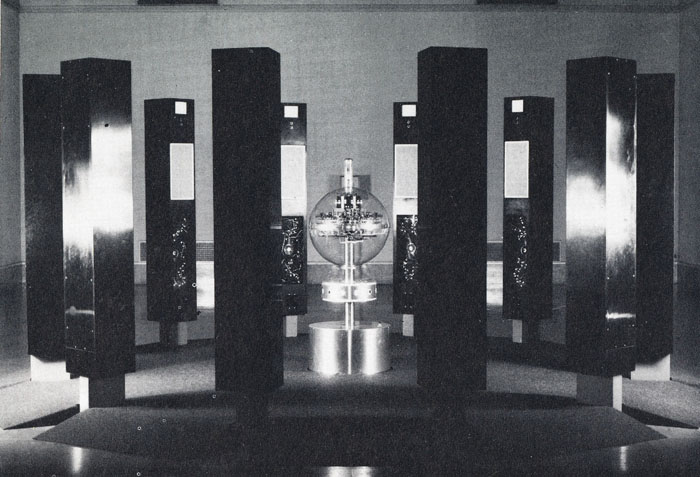

Seawright, James: Electronic Peristyle, 1968, exhibition "The Magic Theatre", William Rockhill Nelson Gallery of Art, Kansas City/Missouri 1968. Photo above: Larry B. Nicholson (Davis: Experiment 1975, p.96). Photo below: James Seawright.
The vertical element with the "plastic sphere" was placed in the middle of a circle built by 12 steles coated with black resopal. In the circle with a diameter of 21 feet (resp. 6,4 m) the visitors walked on an elevated second floor hiding the steles´ support structure constructed of steel and the technical equipment ("multi conducted cables"). The light beams sent from the ring underneath the "central sphere" to the steles hit there on photocells except visitors on the heightened floor interrupted the beams. Photocells paired with mirrors constituted the steles´ "receptors". The mirrors reflected the light beams. These reflexes recorded the photocells within the "plastic sphere". The "shift register" reacted to the photocells´ input produced by the mirrored light beams and their interruptions, as they were caused by the visitors. In the "plastic sphere" the "circuit boards" of the "shift register" are mounted behind the photocells.
This register shifted its "twelve data bits" "at varying rates" "clockwise" "around the twelve stages". The "shift register´s" "12 stages" were "connected in a circle". A "12-bit binary number" was "shifted "by a pulse" in the "circle" from "stage" to "stage". The "stages of the shift register" corresponded with the 12 steles. The "numbers" of each "stage" were "read out by sound synthesizer modules" developed by Robert Moog including "two 8-bit input voltage-controlled oscillators, two 6-bit voltage controlled amplifiers (envelope generators, intermodulators and a voltage controlled filter)."
The data generated by these modules "could be patched into the shift register outputs in a wide range of possibilities": For the programming of a "permanent setup" one of the technical possibilities was selected to coordinate the "shift register" with the "synthesizer modules". The "12-bit binary numbers" circulating between the "stages" resulted in "digital values" causing "the outputs of the synthesizer modules to assume appropriate values -- differing pitches in the case of digital oscillators, different loudness values in the case of amplifiers (or level controls) and so forth, including the timing intervals of the shift register's shifts. A digitally controlled filter could alter overall timbre, etc." before the "mixed audiosignal" was "sent out" to the steles´ loudspeakers. By walking on the heightened floor visitors could listen to "...the constantly changing data decoded into a melodious, background of sound".
Meanwhile the "central sphere" produced sounds the light beam interruptions caused by visitors were recorded by the steles´ photocells and thus started further sound productions: Slowly louder growing "low frequency tones" were emitted by the steles´ loudspeakers into the circle with "a few Hz differences to each other so that the sounds `beat´ against each other". If these sounds "reached a sufficient threshold" then "the tone generators" were switched off. This switch activated "ventilation blowers" in the steles producing "a gentle breeze" in the height of the visitors´ feet.
The "composite audio output" sent from the "central unit" to the steles was mixed "in each stele" with its "low frequency tones". These mixes were made audible by the loudspeakers of the steles.
The light beam interruptions produced by the visitors and registered by the "photocells" within the "plastic sphere" "change the state of the data bits in the stages of the shift register": In a technical sense the data circulation between the "stages" was produced system internal by a "pulse" as well as system external by visitors. But spatially these visitors don´t act from outside, they move in the circle of steles: They act and react to the system´s output from within the environment.
"A rotating scanner atop the plastic sphere overrode the data currently in the shift register once every two minutes" to avoid with a "fresh start" that all "twelve bits" of this register were "set to all ones or all zeros" and could thus cause "a `lock-up´ state".
In the plastic sphere pairs of yellow and white lamps indicated "the instantaneous state of each stage of the shift register". The upper yellow lamp "lighted to denote a state of `1´ and the lower [white lamp] to indicate `0´." For each "state" a lamp pair indicated with "1" or "0" if visitors activated the coordinated "photocell" in the "plastic sphere" ("photocell" – "state" – "lamp pair"). Furthermore the pairs of lamps marked the changes of the "states" effected by the "shift register". "Other sets of [green and red] lamps denoted the states of the digital inputs of the audio synthesizer modules."
Seawright integrated the visitor into the installation by offering her/him only there to disturb and activate the functions for wind, light, and sound. Visitors could use the "changes of the audio program" and the lamps in the "plastic sphere" to control if the system reacts to their motions between the steles and "the plastic sphere". 38
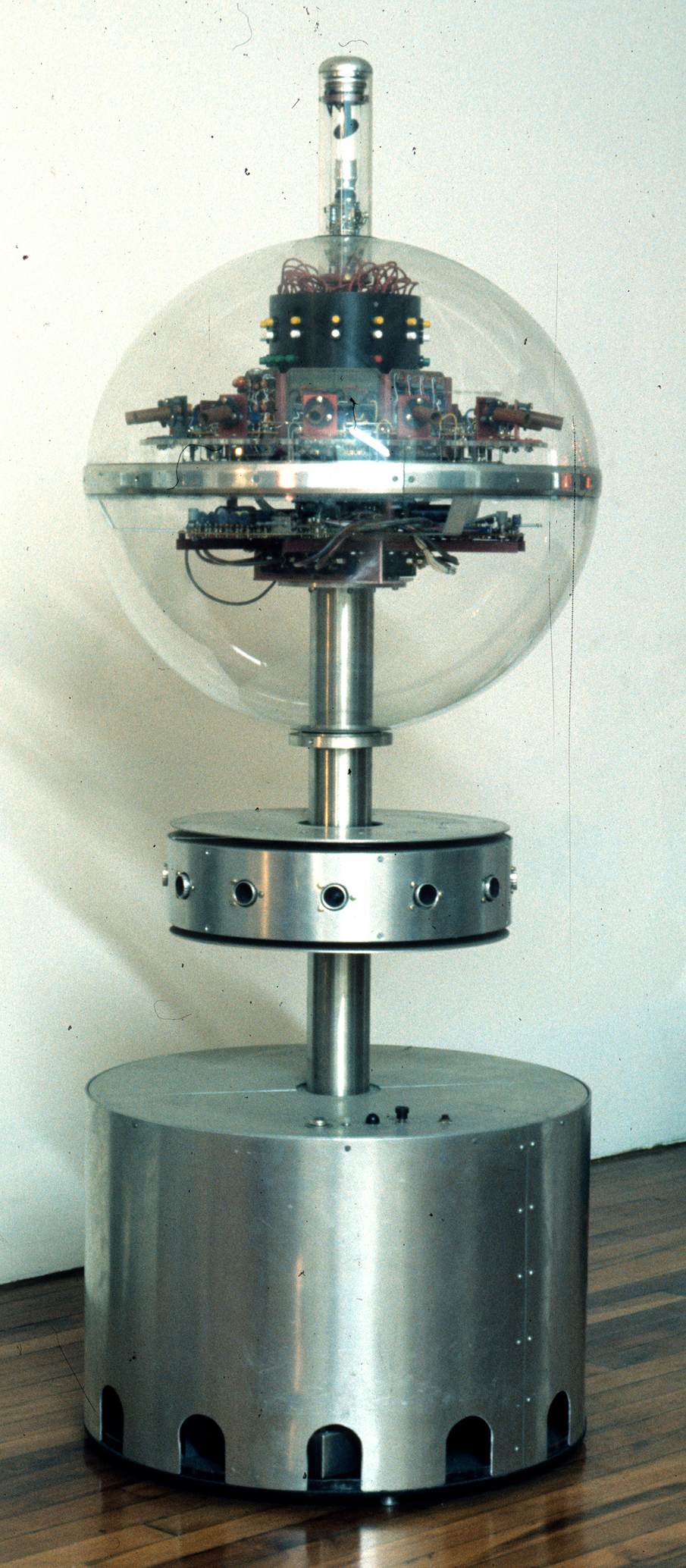
Seawright, James: Electronic Peristyle, 1968, "central unit" removed from the installation. The transparent "plastic sphere" is divided by a "metal band". In the lower half "the circuitry of the sound synthesizer" is visibly installed. Above the "metal band" the 12 photocells are recognisable, "looking a bit like little cannons". The "black metal drum" contains the lamps indicating states of the "shift register" and the "audio synthesizer modules". Above the "metal drum" are the cables of the "patch panel". The "rotating scanner" is located on top of the "plastic sphere" (photo and quotes: James Seawright).
Vladimir Bonacic used minicomputers early. In 1969 he and Miro Cimerman started in Zagreb to use the computers PDP-8 of the Digital Equipment Corporation (DEC) and SDS 930 of Scientific Data Systems with "self built electronics" to produce "pseudo-chance-transformers and generators" via Galois fields. 39 The calculated polynomial equations (of Abstract Algebra) were "implemented into the electronic circuits of a control unit" 40 producing light sequences on grids with sometimes different coloured elements.
In "G.F.E. (16,4)" (1969-71) visitors could modificate light sequences by using cotrollers and a remote control (via radio waves). Three Galois field generators produced the sequences on 1024 light elements with 16 colour hues. The light elements constituted a "dynamic object" measuring 1,78 x 1,78 x 0,20 meter. 41 64 sound oscillators produced sounds by interactions with the Gallois field generators. The sounds became audible by two stereo amplifiers. As indicated by Bonacic the "dynamic object...was capable" to produce "1 048 576 different configurations" by different adjustments from the most rapid in six seconds to the slowest in 24 days. "Each image" was accompanied by "a specific sound". 42
Bonacic, Vladimir: G.F.E. (16,4), 1969-71.
Compared to Seawright´s "Electronic Peristyle" Bonacic developed the light and sound variations to further differentiations, but neglected the integration of observers into the installation´s space by uncommon interfaces and arrangements of the material elements.
In 1971 Seawright´s "Network III" was installed at the Walker Art Center in Minneapolis. If visitors walked on pressure-sensitive elements then they produced patterns on a grid of overhead lights placed directly above the sensors. "6 x 6 arrays of pressure-sensitive mats, normally used to control the opening of automatic doors" were hidden under " a 20´ x 20´ [6,09 x 6,09 m] square of industrial carpeting". On the ceiling 400 lamps were mounted "at the intersections" of "a grid of web-belting" "at an 11´´ [28 cm] interval".
The input of the floor sensors was prepared by a minicomputer PDP 8-L. It executed programmed algorithms structuring the lights to build patterns. The computer, hidden under a white box, could control each light.
To the moves of one or two visitors the program reacted with light patterns. Seawright programmed in the "PDP 8 assembly language" "a circle about two feet [60,96 cm] diameter" with a "blinking circle" as its variant. "A cross or plus sign" could appear as "rotating", too. Furthermore a certain sensor´s input caused "a solid square box" as an output.
If three or more visitors entered the carpet, then the program shut down with "a spectacular blowup". The "processing speed and memory capacity" of the minicomputer were insufficient for algorithms enabling the system to react with light patterns to more than two persons. The program identified the persons on the sensors as "target 1" or "target 2" and assigned to them different "overhead patterns". If both visitors moved to "adjacent" sensors then the "overhead patterns" for "target 1" and "target 2" "would superimpose, but when either one moved to a new location their identities (the coordination visitor – target) would sometimes be exchanged." 43
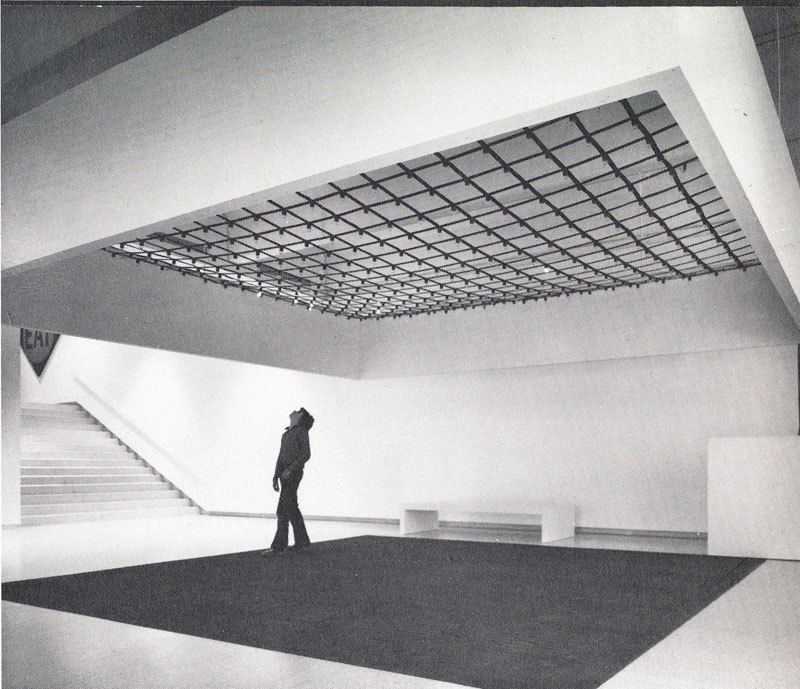
Seawright, James: Network III, 1971, Walker Art Center, Minneapolis 1971. Photo: Eric Sutherland (Davis: Experiment 1975, p.195).
Seawright anticipated interfaces of computer-aided installations of the nineties (see chap. V.1) in "Network III" with its pressure-sensitive floor sensors and the location of the visitors between planes for in- and output. In the nineties Seawright´s patterns for sounds and lights are substituted by digital simulations of three-dimensional spaces and interfaces like floor panels are used as opportunities for observers to switch between real and virtual spaces. 44
In 1967 the "Architecture Machine Group", directed by Nicolas Negroponte and located in the Urban Systems Laboratory at MIT (Massachusetts Institute of Technology, Cambridge/Massachusetts), developed the computer-aided design system "URBAN5" for architects to be used as a means to ameliorate planning procedures. Planners could operate with the system via keys on a console and a light pen for the activation of functions on the screen. Cubes were the basic elements of the graphic system. For Negroponte "URBAN5" was not complex enough for a change of planning strategies. 45
The Architecture Machine Group: Urban 5, 1967.
Meanwhile "URBAN 5" was not capable to integrate the environment into planning procedures 46, "The Architecture Machine" was a learning system with a mobile unit containing photocells. The system was able to recognize environmental conditions and a robot arm developed by students could move stereometric elements on a table.
The "Minsky/Papert-eye" developed at MIT could recognize stereometric elements. It was a result of a research to transfer the contours of a constellation of bodies on a table into a data landscape. The data were processed by the minicomputer Interdata Model 3. The parameters of a learning robot should "develop its own conditioned reflexes" 47 in interactions with an architect. This was the research goal of the project being oriented to "architectural intelligence". 48

Minsky/Papert Eye, M.I.T. (Negroponte: The Architecture Machine 1970, p.106).
In 1970 Jack Burnham curated the exhibition "Software" in the Jewish Museum in New York. "The Architecture Machine Group" realised in the installation "Seek" an environment for 500 gerbils enclosed in a glass container open at the top. An arm was mounted on two rails on the top of the glass container. The arm moved a magnet to replace blocks. Via sensors reacting to pressure the system used an Interdata Model 3 computer to control mouses moving the blocks out of the grid structure. Then the computer activated the moving arm placing the blocks into another structure following the right angle of the grid. 49
The Architecture Machine Group: Seek, 1970, exhibition "Software", The Jewish Museum, New York 1970 (Negroponte: Architecture 1975, p.46, fig.1).
The intended "artificial intelligence" 50 provoked expectations that the arm and its computer-controlled navigation reacts directly to the mice´s actions. 51 The Architecture Machine Group´s contribution to the catalogue points to the still existing gap between "Seek" and the project of "artificial intelligence": "...`Seek´ deals with elementary uncertainties in a simple-minded fashion." 52
The Group presents with "Seek´s" relation between animals and machine a rudimentary model of a social system reacting with a machine-controlled flexibility to the creatures´ motions within the system. With that model The Architecture Machine Group anticipates the model of a flexible architecture as it became an ideal for many architects in the seventies and was realised in projects like Cedric Price´s "InterAction Centre" (Kentish Town, from 1976 to its demolition in 2003) and the Centre Pompidou (Paris, 1977) by Renzo Piano and Richard Rogers. Meanwhile these buildings first of all offered possibilities for a flexible use by elements displacable within a supporting structure, in 1976-79 Cedric Price, John and Julia Frazer designed the "Generator Project" with sensors to whose input react four computer programs, and a mobile crane installed permanently to move flexible elements. The crane shall be a means for the execution of propositions for modifications planned by computers. These propositions react to the sensors´ input containing data on the use of the flexible elements. According to John Frazer the computer programs shall offer better propositions for the users of a house than their own plans: Gordon Pask´s "Learning machines" (see chap. II.3.1.1) and "The Architecture Machine" with its concern to the environment´s changes caused by its use become model examples for the further development of flexible architectural structures. 53
In the sixties the project of an expansion from sculpture to the environment and to action has been realised in different ways. The development of "responsive environments" as a forerunner to a "responsive architecture" 54 was shaped by the possibilities of computer-aided organization procedures. Limits of art are transgressed by demonstrations of non-realizable architectural concepts. The model "Seek" installed by the MIT in the exhibition "Software" anticipated more extensive future-oriented projects and implicated research tasks. The experimental status of the animals in "Seek" was controversial for art critics and provoked them to express doubts about the research goal. 55
Dr. Thomas Dreher
Schwanthalerstr. 158
D-80339 München
Germany.
Homepage
with numerous articles on art history since the sixties, a. o. on Concept Art and Intermedia
Art.
Copyright © (as defined in Creative
Commons Attribution-NoDerivs-NonCommercial 1.0) by the author, October
2011 and October 2013 (German version)/August 2013 and October 2013 (English
translation).
This work may be copied in noncommercial contexts if proper credit is
given to the author and IASL online.
For other permission, please contact IASL
online.
Do you want to send us your opinion or a tip? Then send us an e-mail.
Annotations
1 Pask: Approach 1961, p.32, pl. I(i). In 1955 C.E.G. Bailey, T. Robin McKinnon Wood, and Gordon Pask developed "Eucrates" (Pask: Approach 1961, p.67). back
2 Pask: Approach 1961, p.67s. back
3 Pask: Approach 1961, p.68. back
4 Pask: Approach 1961, p.70. Cf. Burnham: Modern Sculpture 1978, p.337s. back
5 Pask: Comment 1971, p.77-88; Pickering: Brain 2010, p.317ss.; Rosen: Control 2008, p.136-145. back
6 Pask: Comment 1971, p.78. back
7 Pask: Comment 1971, p.80. Cf. Pickering: Brain 2010,
p.316.
Pask: Comment 1971, p.78 on the musician: "The musical performer
(who may, incidentally, be replaced by a small group or band) must first
be able to see the visual display and second be able to modify his performance
according to what he sees. The latter condition can be satisfied in various
ways. At one extreme, the performer has a (usually memorized) score and
he modifies his performance by giving a different interpretation to the
piece. At the other extreme, he improvises in a fashion that is only constrained
by canons of music and his own disposition." back
8 Pask: Comment 1971, p.78ss.; Pickering: Brain 2010, p.314, fig. 7.2, p.316; Rosen: Control 2008, p.136. back
9 Pask: Comment 1971, p.86.
Gordon Pask´s "electro-chemical display" is a part of
a research investigating the relations between "stability and variety"
in "self-organizing systems". In the course of the research
Pask began to develop "chemical computers": "Chemical computers
arise from the possibility of `growing´ an active evolutionary network
by an electro-chemical process." (Pask: Approach 1961, p.105) On
the insights in emergence that Pask was able to win within the research
project: Cariani: Emergence 1991, p.789; Cariani: Ear 1993; Pickering:
Brain 2010, p.334-343; Whitehead: Metacreation 2004, p.223. back
10 Pask: Comment 1971, p.78ss. back
11 Pask: Comment 1971, p.86: "From the performer´s point of view, training becomes a matter of persuading the machine to adopt a visual style which fits the mood of his performance. At this stage in the development of the rapport, the performer conceives the machine as an extension of himself, rather than as a detached or disassociated entity." back
12 Pask: Approach 161, p.48: "A system is `self-organizing´ if the rate of change of its redundancy is positive." back
13 Pask: Approach 1961, p.48. In this case the musician
is the "observer".
Pask describes "observers" as "men, animals, or machines
able to learn about their environment and impelled to reduce their uncertainty
about the events which occur in it, by dint of learning." (Pask:
Approach 1961, p.18) "Some simplified abstractions from the real
world" can be falsified in their character as fundamentals for predictions:
"Any observation of the real world is fallible..." (Pask: Approach
1961, p.19) Learning became a presupposition to obtain sufficient "requisite
variety" (Pask: Approach 1961, p.51ss.; see chap. II.1.5) for adequate
reactions to environmental events. back
14 "Responsive environment": Burnham: Aesthetics 1970, p.108; Burnham: System Esthetics 1968, p.35; Krueger: Computer 1976; Krueger: Environments 1977/1996, p.481s.; Krueger: Videoplace 1985, S.145,147. back
15 Bruinsma, A.H.: Practical Robot Circuits. A Philips
Technical Publication. Quoted in: Hoggett: CYSP 1 2009. Jean-Noël
Montagné in 10/27/2013 in an e-mail to the author.
The name "CYSP" is an abbreviation. It consists of the first two letters
of «cybernétique» and «spatiodynamique»
(Cassou/Habasque/Ménétier: Schöffer 1963, p.50).
On a justified criticism of the term "electronic brain", published
in 1951 in the leaflet of the Science Museum in South Kensington for the
"Festival of Great Britain" in London: see chap. VII.1.1 on
"Ferranti NIMROD". back
16 Hoggett: CYSP 1 2009; Schöffer: Apparitions 2009 and Jean-Noël Montagné in 10/27/2013 in an e-mail to the author. Following Montagné "CYSP 1" was self-navigating and "not programmable...but there were 2 speeds possible for the main moving motors". The external control is not illustrated and only indirectly described in Cassou/Habasque/Ménétrier: Schöffer 1963, p.50-57,137. back
17 Without author: CYSP 1. In: Reichardt: Cybernetic Serendipity 1968, p.45: "...the sculpture consisting of combined travel and animation. For example: it is excited by the colour blue, which means that it moves forward, retreats or makes a quick turn, and makes its plates turn fast; it becomes calm with red, but at the same time it is excited by silence and calmed by noise. It is also excited in the dark and becomes calm in intense light." back
18 Nicolas Schöffer talking to Hans-Jürgen
Buderer in 30.9.1983. In: Buderer: Kinetische Kunst 1992, p.191 (cf. Buderers
comment, ibid., p.127s.).
Cf. Jacques Bureau´s "Annotations of the Philips Company..."
(1955). In: Cassou/Habasque/Ménétrier: Schöffer 1963,
p.45: An "indifference cell" causes an "uncertainty factor"
(Cf. Cassou/Habasque/Ménétrier: Schöffer 1963, p.50,60,136).
back
19 Buderer: Kinetische Kunst 1992, p.124s.,190,193s. (Schöffer 1983, see ann.18); Schöffer: Spatiodynamisme 1955 (I thank Jean-Noël Montagné for the tip about that text). Bureau presents the "electronic brain" in "Annotations of the Philips Company..." (see ann.18) as "homeostat" (Cassou/Habasque/Ménétrier: Schöffer 1963, p.45s.). back
20 Klütsch: Computergrafik 2007, p.198ss.; Mason: Computer 2008, p.101-110; Prince: Women 2003, p.3s.; Reichardt: Serendipity 1968, p.5. back
21 Reichardt: Cybernetics 1971, p.11. In contrary, according to Michael Kustow, the former director of the Institute of Contemporary Arts, the show attracted 45.000 visitors (Usselmann: Dilemma 2003, ann.4). "Cybernetic Serendipity" was a travel exhibition shown in 1969 in the Corcoran Art Gallery (Washington, D.C.) and in the Exploratorium in San Francisco, too (Henning: Museums 2006, p.87ss.; Mason: Computer 1968, p.212). back
22 Reichardt: Computer 1971; Reichardt: Cybernetic Serendipity 1968; Reichardt: Cybernetics 1971. back
23 Ihnatowicz: Cybernetic Art 1986, p.5; Ihnatowicz: Forty 2008, p.113; Mason: Computer 2008, p.81s.; Reichardt: Cybernetic Serendipity 1968, p.38; Zivanovic: SAM 2005, p.2s.; Zivanovic: Technologies 2008, p.97ss. back
24 Ihnatowicz, Edward: Sound-Activated Mobile. In: Reichardt: Cybernetic Serendipity 1968, p.38. back
25 Philips P 9201: clone of the minicomputer Honeywell DDP-416 (since 1967. See Zivanovic: Technical Info undated; Zivanovic: SAM 2005, p.4). The computer was located in view beside the round base. back
26 Ihnatowicz: Cybernetic Art 1986, p.6. back
27 Mason: Computer 2008, p.91; Zivanovich: SAM 2005, p.5. Further writings on "Senster": Benthall: Ihnatowicz 1971; Gardner: Elephants 1983, p.143-146; Ihnatowicz: Forty 2008, p.114s.; Zivanovic: Technologies 2008, p.100-107. back
28 Realisation of the fibreglass bodies: Pip and Adele Youngerman (Rosen: Control 2008, p.167 with ann.128). back
29 Pask: Comment 1971, p.97 with fig. 40, p.98. Electronics: Mark Dowson. Electromechanics: Tony Watts. The computer was constructed by Pask, Dowson and Watts using "electromechanical relais and simple electronics " (Rosen: Control 2008, p.168 with ann.129). back
30 Pask: Comment 1971, p.89. back
31 Pask: Comment 1971, p.89. Cf. Pickering: Brain 2010, p.357s.; Rosen: Control 2008, p.168. back
32 "Odrive and Pdrive", in: Pask: Comment 1971, p.91. back
33 Pask: Comment 1971, p.88s. back
34 Pask: Comment 1971, p.91. back
35 Pask: Comment 1971, p.88. back
36 On the problem to inform visitors about the system´s fundamentals to enable them to reconstruct the programming of its functions by activating its machinic reactions: Rosen: Control 2008, p.172 with ann.136. Cf. in contrary Pickering: Brain 2010, p.360 on visitors interacting with "Colloquy of Mobiles" for several hours without preinformations. back
37 Group exhibition "The Magic Theatre", William Rockhill Nelson Gallery, Kansas City/Missouri 1968. Later exhibited in the art museums of St. Louis/Missouri and Toledo/Ohio. In: Davis: Art 1973, p.75s.,156; Ehrlich: Magic Theatre 1969. Permanent installation of "Electronic Peristyle" since 1997: New Jersey State Museum, Trenton/New Jersey. back
38 Quotes from e-mails sent by James Seawright to the
author in 9/28/2013, 10/7/2013, 10/10/2013 and 17/10/2013.
Writings on "Electronic Peristyle": Kostelanetz: Soho 2003,
p.153; Light: Peristyle 1997; Seawright: Art 1970, p.89,91ss. back
39 Rosen: Maschinen 2007, p.50. The SDS 930 was programmed in FORTRAN and assembly language (Frits: Work 2011, p.51). back
40 Rosen: Maschinen 2007, p.51. back
41 Bonacic: Mensch 1973, p.216: "The dynamic object GF E 16-4/69-71...was constructed with 1024 quadratic aluminium tubes. Because of the tubes´ different length the object constituted a relief. At the end of each tube a transparent glass in one of 16 colour hues is mounted (antique glass made in West Germany). Each tube contains a lamp for a control independent of the arithmetic unit of the computer." back
42 Bonacic: Mensch 1973, p.217. Cf. Fritz: Work 2011, p.52s.; Shanken: Art 2009, p.67. back
43 Quotes from e-mails sent by James Seawright to the
author in 10/6/2013 and in 10/10/2013.
Seawright about the programming:
"The programming was all mine, with considerable advice and hand-holding
from computer professionals and hackers. The language was PDP8 assembly
language. The program was coded in ASCII on paper tape, and read in using
the teletype which came with the computer. Loading or reloading the program
took over 4 hours!"
Seawright expanded the program for the installation in the group exhibition
"The Responsive Environment", New Jersey State Museum, Trenton/New
Jersey 1972.
Writings on "Network III": Davis: Art 1973, p.156; Goodman:
Visions 1987, p.142; Kac: Telepresence 2005, p.176s. back
44 Cf. Weibel, Peter: On Justiying the Hypothetical Nature of Art and the Non-Identicality within the Object World, 1992 (see chap. V.1); Rogala, Miroslav: Lovers Leap, 1995. In: Druckrey: Lovers Leap 1995. back
45 Negroponte: The Architecture Machine 1970, p.70-99. back
46 Negroponte: The Architecture Machine 1970, p.63. back
47 Negroponte: The Architecture Machine 1970, p.100-117.
"The M.I.T. Minsky/Papert eye": Negroponte: The Architecture
Machine 1970, p.105ss. At the MIT Artificial Intelligence Lab Marvin Minsky
and Seymour Papert developed among other things "The Logo Turtle"
in 1969 (Hoggett: Logo Turtle 2010), using "LOGO" to develop
further William Grey Walter´s robots (see chap. II.2.3). "LOGO"
is a computer language developed in 1967 and is based on LISP ("LOGO"-developer:
Wally Feuerzeig, Seymour Papert).
On Papert, Minsky, Negroponte and "The Architecture Machine"
as documents for relations between art and "artifical intelligence":
Burnham: Aesthetics 1970, p.111-114. back
48 Steenson: Artificial Intelligence 2010. back
49 The Architecture Machine Group: Seek 1970 (students at M.I.T. constructed "Seek" as members of the "Architecture Machine Group"); Davis: Art 1973, p.101s.,107; Goodman: Visions 1987, p.40s.,43; Hess: Gerbils 1970; Montfort/Wardrip-Fruin: Reader 2003, p.247; Negroponte: The Architecture Machine 1970, p.104s.,112s.; Pickering: Brain 2010, p.376s., fig. 7.27. back
50 The Architecture Machine Group: Seek 1970. back
51 Davis: Art 1973, p.102; Goodman: Visions 1987, p.40. back
52 The Architecture Machine Group: Seek 1970. back
53 On the "InterAction Centre": Mathews:
Agit-Prop 2006, part 2 and 3.
On the "Generator Project": Pickering: Brain 2010, p.372s.;
Steenson: Cedric Price 2007. back
54 Grünkranz: Phenomenology 2009.
On the art expansion in the sixties from the isolated object to the environment
and to architecture: Claus: Expansion 1970, esp. p.54-109; Krauss: Sculpture
1979. back
55 Davis: Art 1973, p.107; Hess: Gerbils 1970; Goodman: Visions 1987, p.43. back
[ Table of Contents | Bibliography | Next Chapter ]
[ Top | Index NetArt | NetArt Theory | Home ]
